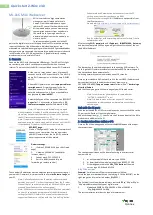
8
Steelhead Appliance Installation and Configuration Guide
Overview of the Steelhead EX
WAN Optimization
The Riverbed Optimization System (RiOS) intercepts client-server connections without interfering with
normal client-server interactions, file semantics, or protocols. All client requests are passed through to the
server normally, while relevant traffic is optimized to improve performance.
The optimization techniques RiOS utilizes are:
Data Streamlining
-
Steelhead appliance
s and Steelhead Mobile can reduce WAN bandwidth utilization
by 65% to 98% for TCP-based applications using Data Streamlining. In addition to traditional
techniques like data compression, RiOS also uses a Riverbed proprietary algorithm called Scalable
Data Referencing (SDR). SDR breaks up TCP data streams into
unique
data chunks
that are stored in the
hard disk (
RiOS data store
) of the device running RiOS (a Steelhead appliance or Steelhead Mobile host
system). Each data chunk is assigned a unique integer label (
reference)
before it is sent to a peer RiOS
device across the WAN. When the same byte sequence is seen again in future transmissions from
clients or servers, the reference is sent across the WAN instead of the raw data chunk. The peer RiOS
device (a Steelhead appliance or Steelhead Mobile host system) uses this reference to find the original
data chunk in its RiOS data store, and reconstruct the original TCP data stream.
Transport Streamlining
-
Steelhead appliance
s use a generic latency optimization technique called
Transport Streamlining. Transport Streamlining uses a set of standards and proprietary techniques to
optimize TCP traffic between
Steelhead appliance
s. These techniques:
–
ensure that efficient retransmission methods, such as TCP selective acknowledgements, are used.
–
negotiate optimal TCP window sizes to minimize the impact of latency on throughput.
–
maximize throughput across a wide range of WAN links.
Application Streamlining
- In addition to Data and Transport Streamlining optimizations, RiOS can
apply application-specific optimizations for certain application protocols: for example, CIFS, MAPI,
NFS, TDS, HTTP, Oracle Forms.
Management Streamlining
- Management Streamlining refers to the methods that Riverbed has
developed to simplify the deployment and management of RiOS devices. These methods include:
–
Auto-Discovery Process
- Auto-discovery enables
Steelhead appliance
s and Steelhead Mobile to
automatically find remote
Steelhead appliance
s and to use them to optimize traffic. Auto-discovery
relieves the burden of manually configuring large amounts of network information. The auto-
discovery process enables administrators to control and secure connections, specify traffic to be
optimized, and specify peers for optimization.
–
Central Management Console (CMC)
- The CMC enables remote
Steelhead appliance
s to be
automatically configured and monitored. It also provides a single view of the overall benefit and
health of the
Steelhead appliance
network.
–
Steelhead Mobile Controller
- The
Mobile Controller
is the management appliance that tracks the
individual health and performance of each deployed software client, and to manage enterprise
client licensing. The Mobile Controller enables you to see who is connected, view their data
reduction statistics, and perform support operations such as resetting connections, pulling logs,
and automatically generating traces for troubleshooting. You can perform all these management
tasks without end user input.















































